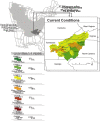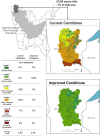Valuing improvements in the ecological integrity of local and regional waters using the biological condition gradient
- PMID: 37094119
- PMCID: PMC10160978
- DOI: 10.1073/pnas.2120251119
Valuing improvements in the ecological integrity of local and regional waters using the biological condition gradient
Abstract
Scientific knowledge related to quantifying the monetized benefits for landscape-wide water quality improvements does not meet current regulatory and benefit-cost analysis needs in the United States. In this study we addressed this knowledge gap by incorporating the Biological Condition Gradient (BCG) as a water quality metric into a stated preference survey capable of estimating the total economic value (use and nonuse) for aquatic ecosystem improvements. The BCG is grounded in ecological principles and generalizable and transferable across space. Moreover, as the BCG translates available data on biological condition into a score on a 6-point scale, it provides a simple metric that can be readily communicated to the public. We applied our BCG-based survey instrument to households across the Upper Mississippi, Ohio, and Tennessee river basins and report values for a range of potential improvements that vary by location, spatial scale, and the scope of the water quality change. We found that people are willing to pay twice as much for an improvement policy that targets their home watershed (defined as a four-digit hydrologic unit) versus a more distant one. We also found that extending the spatial scale of a local policy beyond the home watershed does not generate additional benefits to the household. Finally, our results suggest that nonuse sources of value (e.g., bequest value, intrinsic aesthetic value) are an important component of overall benefits.
Keywords: Clean Water Act; stated preferences; water pollution; willingness to pay.
Conflict of interest statement
The authors declare no competing interest.
Figures






Similar articles
-
A bioassessment approach for mid-continent great rivers: the Upper Mississippi, Missouri, and Ohio (USA).Environ Monit Assess. 2009 May;152(1-4):425-42. doi: 10.1007/s10661-008-0327-1. Epub 2008 May 16. Environ Monit Assess. 2009. PMID: 18483771
-
Valuing Ecological Improvements in the Chesapeake Bay and the Importance of Ancillary Benefits.J Benefit Cost Anal. 2018 Spring;9(1):1-26. doi: 10.1017/bca.2017.9. Epub 2017 Jun 15. J Benefit Cost Anal. 2018. PMID: 31080702 Free PMC article.
-
Estimating biotic integrity to capture existence value of freshwater ecosystems.Proc Natl Acad Sci U S A. 2023 May 2;120(18):e2120259119. doi: 10.1073/pnas.2120259119. Epub 2023 Apr 24. Proc Natl Acad Sci U S A. 2023. PMID: 37094141 Free PMC article.
-
Using ecotechnology to address water quality and wetland habitat loss problems in the Mississippi basin: a hierarchical approach.Biotechnol Adv. 2003 Dec;22(1-2):135-59. doi: 10.1016/j.biotechadv.2003.08.012. Biotechnol Adv. 2003. PMID: 14623048 Review.
-
Sources, pathways, and relative risks of contaminants in surface water and groundwater: a perspective prepared for the Walkerton inquiry.J Toxicol Environ Health A. 2002 Jan 11;65(1):1-142. doi: 10.1080/152873902753338572. J Toxicol Environ Health A. 2002. PMID: 11809004 Review.
Cited by
-
Perspectives on valuing water quality improvements using stated preference methods.Proc Natl Acad Sci U S A. 2023 May 2;120(18):e2217456120. doi: 10.1073/pnas.2217456120. Epub 2023 Apr 24. Proc Natl Acad Sci U S A. 2023. PMID: 37094166 Free PMC article.
-
Measuring the social benefits of water quality improvements to support regulatory objectives: Progress and future directions.Proc Natl Acad Sci U S A. 2023 May 2;120(18):e2120247120. doi: 10.1073/pnas.2120247120. Epub 2023 Apr 24. Proc Natl Acad Sci U S A. 2023. PMID: 37094157 Free PMC article. No abstract available.
References
-
- U.S. Environmental Protection Agency, National Water Quality Inventory: Report to Congress. EPA-841-R-16-011 U.S. Environmental Protection Agency, Washington, D.C. (2017). https://www.epa.gov/sites/default/files/2017-12/documents/305brtc_finalo...
-
- Stets E. G., et al. , Landscape drivers of dynamic change in water quality of U.S. rivers. Environ. Sci. Technol. 54, 4336–4343 (2020). - PubMed
-
- Freeman A. M. III, Air and Water Pollution Control: A Benefit-Cost Assessment (John Wiley & Sons, Inc., New York, 1982).
Publication types
MeSH terms
LinkOut - more resources
Full Text Sources
Miscellaneous

